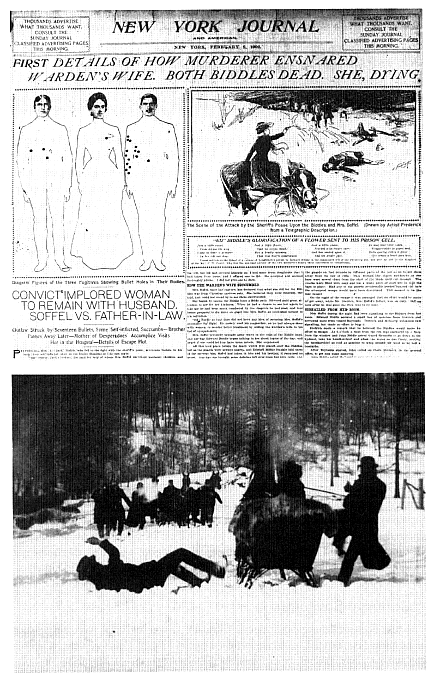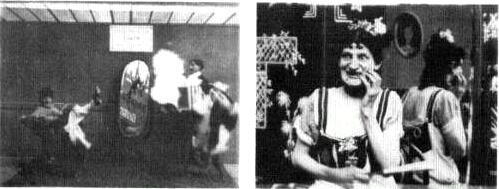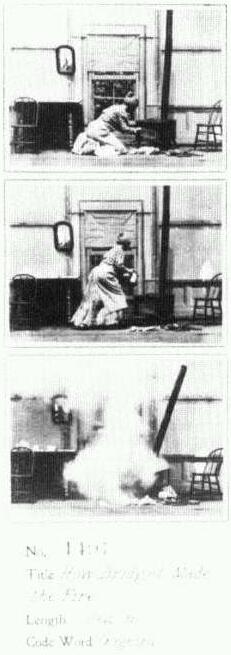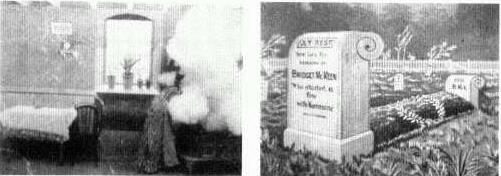Editorial Strategies
Most Porter/Fleming productions from the winter of 1901 were single-shot acted films between fifty and one hundred feet in length. These depicted a simple gag with a clear, though brief, Aristotelian construction—a beginning, middle, and end. In The Old Maid Having Her Picture Taken , the woman is so unattractive that when she looks into a mirror, it cracks and falls to the floor. When
Capture of the Biddle Brothers.
Exhibitors were urged to show Old Maid Having Her Picture
Taken and Old Maid in the Drawing Room as a larger unit.
she poses for a picture and looks into the lens, the camera explodes. This comedy featured Gilbert Saroni, a well-known vaudeville performer and female impersonator who specialized in playing unattractive old maids in vaudeville sketches like "The Giddy Girl."[24]The Old Maid in the Drawing Room (copyrighted as The Old Maid in the Horse Car ) was a facial expression film with Saroni photographed in close-up as he talked to the camera. "Her facial expressions are extremely humorous," declared one Edison catalog, "and when this picture was first shown in New York City, the audience was convulsed with laughter."[25] It was suggested that the old maid was busy talking about her adventures at the photo gallery. Thus, if an exhibitor desired, he could combine these two single-shot films to create a more elaborate subject. By giving the audience a better view of a face that was capable of destroying a camera, the exhibitor could introduce a self-reflexive element that only added to the farce.
From the outset, however, Porter and Fleming produced a significant number of multishot acted films, thus assuming control over the editorial function in select circumstances. The first scene of Terrible Teddy, the Grizzly King is described in an Edison catalog:
A burlesque on Theodore Roosevelt hunting mountain lions in Colorado and taken from the New York Journal and Advertiser. The scene opens in a very picturesque wood. Teddy with his large teeth is seen running down the hill with his gun in hand, followed by his photographer and press agent. He reconnoitres around a large tree and finally discovers the mountain lion. He kneels on one knee and makes a careful shot. Immediately upon the discharge of his gun a huge black cat falls from the tree and Teddy whips out his bowie knife, leaps on the cat and stabs it several times, then poses while his photographer makes a picture and the press agent writes up the thrilling adventure. A side splitting burlesque.[26]
In the next scene, unmentioned in the Edison catalog, the hunter and his retinue
Biograph's How Bridget Made the Fire.
The Finish of Bridget McKeen.
are shown coming down a path: visual continuity and narrative coherence between the first and second shots are disrupted by the sudden appearance of a new pro-filmic element—Teddy's horse. Although Kemp Niver has suggested that there is continuity of space, time, and action between these two shots,[27] the inspiration for the scenes—two cartoon panels printed two weeks apart—offers contextual evidence that indicates this is unlikely. Not strong enough to stand alone as a separate subject, this second shot became commercially viable as a tag to the opening scene.
The Finish of Bridget McKeen , another two-shot comedy made in February, may have been inspired by Biograph's single-shot How Bridget Made the Fire , produced in June of the previous year. Other possible antecedents also existed. Like The Finish of Michael Casey , which Porter made a short time later, this ethnic joke was made at the expense of the "thick-headed" Irish. The first scene was filmed against the backdrop of a kitchen (including the far edge of the ceiling), with a stove, table, and chair as the only real objects on the set. The decor is a schematic, two-dimensional suggestion of a kitchen, just as Bridget, played by a male employee, is a burlesque of a maid rather than a believable portrayal. Using stop-action procedures, Porter replaced the actor, who is using a can marked "kerosine" to start the stove, with a dummy. After an explosion expels the dummy upward out of the scene, pieces of the body/dummy fall to the earth after an abnormally long time.[28] It is this distension of time that provides the scene with one of its key comic elements. The second scene is simply a static, painted backdrop showing Bridget's tombstone, on which is written the well-known ditty "Here Lies the Remains of Bridget McKeen Who Started a Fire with Kerosine." The relationship between the two scenes is easily understood, particularly for English-speaking audiences. Not only is the first shot the cause of the second, but the ditty recounts the previous scene even as it works as an effective punch line.
Another Job for the Undertaker , made two months after The Finish of
Bridget McKeen , has a similar narrative structure. Shot 1 is a typical trick film: when a rube enters his hotel room, its contents and his clothes quickly vanish. "He then walks up to the gas jet and in direct disregard of the sign (which reads 'Don't Blow out the Gas') proceeds to blow out the gas. Three vigorous breaths are consumed in extinguishing the light, when the Rube faces the foreground of the picture with a satisfied look and tumbles into bed. The scene instantly changes to a funeral procession, headed by Reuben's hearse and followed by carriages of his country friends."[29] The second shot was filmed outside using procedures associated with actualities. The editorial combination of disparate mimetic elements is consistent with Porter's use of painted and real pro-filmic elements within a single scene. The syncretic mode of representation is simply taken to another level, utilizing editorial strategies that Porter had learned well as an exhibitor.
Terrible Teddy, the Grizzly King, The Finish of Bridget McKeen , and Another Job for the Undertaker share many characteristics. The first scenes are self-contained narratives constructed like many single-shot films of the period. The only significant difference is the addition of a tag, a short fragment that gained its value in reference to the principal scene. Each tag also represents a shift in representational methods, from narrative to non-narrative, from theatrical to painterly, from trick to actuality, or from movement to stasis. The photographer's editorial prerogatives were still confined to specialized situations. Within these limited possibilities, the films lack phenomenological continuity from one shot to the next: their relationships are aspatial and atemporal. Continuity is restricted to a narrative or thematic level. Porter had not begun to explore the spatial and temporal relations that were to become fundamental to later narrative cinema.
Two multishot films made early in 1901 are significant for yet another reason: they made use of a dissolve. In The Finish of Bridget McKeen , Porter dissolved between the main narrative gag in the kitchen and the tombstone tag. In Why Bridget Stopped Drinking , made about the same time but not copyrighted, Porter used a single camera position for both shots—the dissolve smoothing and clarifying the jump in time. The dissolve, a common screen technique developed in the mid nineteenth century, was executed by exhibitors during the course of projecting slides.[30] It was considered a particularly elegant way to move from one image to the next, preventing sudden jumps when scenes changed. In the late 1890s exhibitors occasionally dissolved from film to film or film to slides, but with mixed success.[31] The technique was not only tricky but required good timing, considerable equipment, and an extra assistant. In transitions from film to film, it was possible and much more practical for dissolves to be made in the motion picture camera or during the printing process. Méliès' Cinderella , which Porter projected at the Eden Musee, was perhaps the first film to contain dissolves: this technique was soon adopted by Blackton and Smith for Congress of Nations . Porter then employed it regularly during 1901-2, con-
cluding with Life of an American Fireman . If nothing else, it gave the production company new opportunities to assume control over the editorial process.
A group of studio films in late April and early May featured the dog known as "Mannie," who appears with his owner, Laura Comstock, in Laura Comstock's Bag-Punching Dog. The film begins with a close view of the duo and then cuts to a vaudeville-type routine probably taken from their act then being performed at Keith's Union Square Theater. Prospective purchasers were told that Mannie's "high jumps and lightning-like punches are remarkable and cause one to marvel at the amount of patience that must be necessary to teach a dog such tricks."[32] The introductory portrait functioned much like the facial expression film in the suggested combination of two Gilbert Saroni comedies discussed above. Here the producer asserted editorial control because the portrait was not strong enough to be sold on its own. It was also placed at the beginning of the picture rather than at the conclusion. Both uses of "emblematic shots" are innovations that can apparently be attributed to Porter, and yet here again caution and qualification are essential. Lantern-slide portraits of Spanish-American war heroes had often been exhibited in conjunction with related scenes. Thus, a portrait of Captain Sigsbee might have preceded the film of his ship, the Maine . Porter, therefore, applied his expertise as an showman to new material and a new situation. It was a significant achievement, but hardly an unexpected departure from previous practice.
Norman H. Mosher—Laura Comstock's husband, her manager, and Mannie's trainer—developed a relationship with Porter that would endure for over five years, during which time Mannie appeared in many Edison productions.[33] At the outset of this association, Mannie played the tramp's nemesis in several Happy Hooligan films. Pie, Tramp and the Bulldog consists of one "shot" of three separate camera takes (or subshots): (1) the tramp indicates to the film spectators that he is hungry, but that the bulldog prevents him from getting to the pie cooling on a nearby window sill, and so he exits the frame; (2) the tramp immediately returns on stilts to outsmart the dog and eat the pie on the ledge; (3) the dog gets the tramp by jumping out the house window, and the two exit with the dog holding onto the tramp's pants. Here Porter spliced together a succession of takes taken from a single camera position to give the illusion of a single, uninterrupted continuity. Rather than using this procedure to create a "trick," he used it for pacing purposes and to construct a narrative that would have been difficult to execute during a single take. (The time occupied by the tramp's off-screen acquisition of stilts was condensed in a way that obeyed theatrical convention.) Pie, Tramp and the Bulldog was praised in a subsequent Edison catalog: "This we believe to be one of the funniest pictures ever put on exhibition. It has had a run of five weeks at Proctor's New York Vaudeville Theatres and the audiences never seemed to tire of it."[34] With the studio in operation only a few months, Porter and Fleming were proving themselves adept producers of short comedies.
The Tramp's Dream , another film in this series, meticulously imitated a Lubin picture of the same title made in late 1899.[35] (Clearly Edison personnel were as ready to "borrow" from their contemporaries as vice versa.)[36] The picture has a more complex shot structure than Porter's previous films: shot (1) the tramp goes to sleep on the park bench; shot (2) the dream—the usual confrontation between the tramp, who wants a free meal, and the dog, which grabs the tramp by his pants; shot (3) a return to shot 1, the tramp is being hit on the foot and shaken by a passing policeman. The last shot explains why the dream ends and also reinforces the parallelism of the tramp being attacked by the dog and the patrolman: he gets no rest in either his dream world or his real world. Not only is there temporal continuity (although its precise nature is not defined), but a movement into and out of the tramp's mind. Subjective images, whether dreams, visions, or a character's subjective "point-of-view," were among the first instances in which cameramen employed sophisticated editorial strategies that created spatial and temporal relations between shots.[37]



